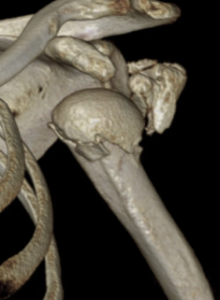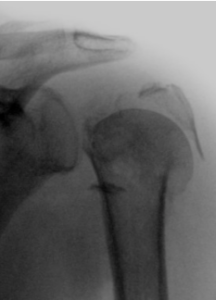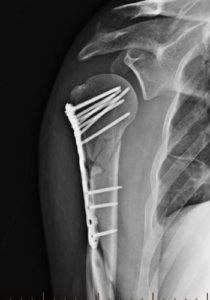Proximal Humerus Fracture
What is a Proximal Humerus Fracture?
A proximal humerus fracture also referred to as a broken humerus, is a break of the shoulder at the top of the upper arm bone. The bone usually fractures just below the ball of the shoulder joint. This can occur in patients of all ages from a variety of traumatic causes. It often results from a fall in an elderly patient or a motorcycle or motor vehicle accident in younger patients.
What Does the Humerus Do?
The proximal humerus is the ball of the shoulder joint. It lets you move your shoulder in circles and allows your muscles to be under the correct tension to maintain strength. Your rotator cuff muscles are attached to this bone. Shoulder arthritis occurs when the cartilage and joint surface of the ball and socket joint becomes irregular.
How is a Proximal Humerus Fracture Diagnosed?
Physical examination and imaging tests are used to diagnose proximal humerus fractures. Accurate and prompt diagnosis of this type of fracture is critical because important blood vessels and nerves run next to this bone and can be injured when it breaks. The doctor will also look for any open wounds over the injury. Sometimes the bone pushes against the skin causing it to “tent.” Too much pressure can result in the bone coming through the skin.
X-rays are used to evaluate the location, type, and severity of the broken bone. This helps doctors and patients make an informed decision on treatment. Often three or more x-rays are taken in the standing position to show the injury pattern. If the bone is broken in many pieces or into the joint a CT (computed tomography) scan is often ordered to help the doctors see the injury better. This is important when deciding if a fracture needs surgery or not and if surgery is planned, what type of surgery is needed.

Preoperative CT scan of shoulder and proximal humerus fracture.

Preoperative x-ray of shoulder and proximal humerus fracture.
Proximal Humerus Fracture Treatment
Most proximal humerus fractures can be treated without surgery if the bone fragments have not shifted out of place. This usually involves some form of physical therapy. If the proximal humerus is broken into many pieces, surgery may be required to realign the bone fragments.
Non-Surgical Treatment
Many proximal humerus fractures do not require surgery and heal just fine without an operation. Minor fractures with minimal displacement do very well with nonsurgical treatment. Science has shown that there is no difference in use of a sling or shoulder immobilizer. These devices are used for support and comfort only. Patients often feel most comfortable sleeping in a recliner or in a bed propped up on several pillows.
If non-operative care is chosen, regular follow-up care for a physical exam and x-rays are important to ensure that the fracture stays in good position and heals appropriately. Cutting down or quitting smoking and tight blood sugar control if you are a diabetic is important for the healing process.
Physical therapy proximal humerus fractures usually begins at three weeks from injury when follow up x-rays demonstrate good maintenance of bone alignment. Therapy starts with gentle range-of-motion exercises and progresses as pain improves and bones continue to heal. To obtain good shoulder motion, it is not uncommon to need 3 to 4 months of therapy and a dedicated home exercise program.
Surgical Treatment
Surgeons may recommend an operation to fix the broken humerus if it is broken into many pieces, if the bones are far apart, if the bone sticks out through the skin, or if the nerves or blood vessels are injured. Several studies have shown that surgery can help to reduce pain, get people back to work sooner and maintains shoulder strength and motion.
Proximal humerus fractures can be fixed with plates and screws or joint replacement depending on the type of injury. Surgery usually takes 1-2 hours and can often be done on a “same day” or outpatient basis. Ideally, surgeons like to perform surgery within 1-2 weeks of injury. Thus, patients have time to seek a second opinion regarding treatment if more information or additional surgeon input is desired.
Fractures can also occur in children around the growth plate. These can also require surgery to keep the bone in the correct position so it grows correctly. Surgeons can sometimes use thin pins or wires to hold the bone in position while it heals. This metal is then removed after the healing process is mature.
Why Choose ROC For Your Proximal Humerus Fracture Surgery?
It is important to choose your surgeon wisely. The lung and several important blood vessels and nerves lie next to this bone. It is possible for these to be injured during surgery. In addition, if joint replacement is selected, persistent instability and catastrophic failure can result from inappropriately placed implants. Extensive surgical experience can be helpful in achieving a good result and avoiding complications. Collectively, ROC surgeons have performed more proximal humerus operations and joint replacements than any practice in Northern Nevada and take pride in outstanding surgical results.
After surgery, patients are allowed to use their arm for gentle activities and a sling for comfort only. Initial range-of-motion exercises are encouraged.

Post-Op X-Ray of Proximal Humerus Fracture
Proximal Humerus Fracture Complications
Multiple complications can occur after proximal humerus fracture surgery. Some of the most common risks and complications include:
- Infections can occur after surgery. A dose of antibiotics given prior to surgery helps to make this risk as small as possible.
- Injury to blood vessels or nerves is a common risk. This is reduced by having an experienced surgeon involved in your care.
- Loose shoulder or instability may occur if a joint replacement is performed. It is possible to have a loose shoulder or instability.
- Broken bones may occur from falls after surgery.
- Some bones may not heal properly even after treatment. This is usually associated with patient noncompliance, diabetes, or use of nicotine like smoking and chewing tobacco.
Nonunion or Malunion
Patients who decide not to have surgery on their broken humerus can develop a nonunion or a malunion.
- A nonunion is when the bone does not heal after 6 months.
- A malunion is when the bone heals but in a bad position.
Both of these conditions can be treated with surgery if a patient has persistent pain and dysfunction. This often involves joint replacement and can result in excellent pain relief and restoration of motion.
Proximal Humerus Fracture Healing Time
Most people with proximal humerus fractures do very well. By six weeks, patients are extremely comfortable and usually are released to full activities such by three months. Continued stiffness is a common problem and prolonged therapy or exercises is often needed. Aggressive return to activity too early can result in re-fracture, hardware breakage or nonunion.
In need of an orthopedic specialist? Schedule an appointment with one of our specialty-trained Trauma and Fracture doctors to talk through your options. Reno Orthopedic Center offers comprehensive treatment for a full range of traumatic injuries at multiple convenient locations in Reno, Sparks and Carson City.
